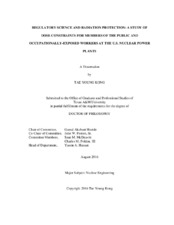| dc.description.abstract | The U.S. Nuclear Regulatory Commission (NRC) is considering a revision of the existing system of radiation protection regulations with respect to ICRP Publication 103. It is expected that there will be a change in the current NRC regulations to require the implementation of concept of dose constraints for members of the public and for occupationally-exposed workers at the U.S. nuclear power plants (NPPs). Under the paradigm of regulatory science, the use of dose constraints is still highly debatable.
This study addressed two objectives. The first objective was determining whether or not dose constraints are necessary for members of the public and occupationally-exposed workers at the U.S. NPPs. The second objective was determining, if dose constraints were needed, the optimal numerical values of dose constraints at the U.S. NPPs. To achieve these objectives, several areas were investigated and analyzed: 1) the establishment of a regulatory-science framework; 2) a system of radiation protection which would incorporate the concept of dose constraints; 3) methodologies and regulations for public and occupational dose assessment; 4) approaches to the establishment of dose constraints; 5) the actual doses for members of the public living around NPPs; and 6) the range of doses for occupationally-exposed workers in NPPs.
As a result of analysis of exposure data, the annual median and maximum doses to a maximally-exposed individual (MEI) for members of the public were 10^-4 and 10^-1 mSv, respectively. The corresponding annual excess risks (ER) for the median and maximum doses were calculated to be on the order of 10^-8 and 10^-6, respectively. These excess risks are low and should be considered acceptable. For occupationally-exposed workers, the average and maximum measurable doses were 1.3 mSv and 24.8 mSv, respectively. The annual excess risks for the average and maximum doses were 10^-5 and 10^-3, respectively. These excess risks are also acceptable from the perspective of occupational risks. This analysis showed that some individuals received relatively higher annual doses than all others. The fraction of the workers in this category was negligible (0.01%) and the economic cost of further dose reduction based on dose constraints will have no net positive benefit. Thus, it is concluded that dose constraints are not necessary for members of the public or occupationally-exposed workers at the U.S. NPPs. | en |


